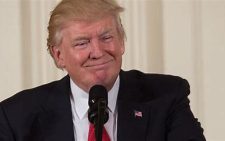US tariffs on southeast Asia meant to contain China

During his “Liberation Day” speech on April 2 from the White House Rose Garden, President Donald Trump questioned how China had surpassed the US in shipbuilding. This rhetorical question highlights a broader strategy: since returning to office, Trump has pursued policies aimed not just at challenging China but isolating it globally. His economic and foreign policy initiatives are deliberately designed to slow Beijing’s rise in industries critical to global leadership such as trade, manufacturing, and military technology.
China’s transformation from one of the world’s poorest nations just 75 years ago to a global economic powerhouse has raised alarms in Washington and its traditional allies. During Trump’s first term, his administration waged a trade war against China, driven largely by concerns over China’s “Made-in-China 2025” initiative – an economic blueprint aimed at making China self-reliant in advanced technologies and industries. This led to a decoupling of the US and Chinese economies, with China reducing dependency on US imports like pork.
While the global economy benefits from peaceful cooperation between the US and China, even minor frictions between Washington and Beijing have significant consequences, causing supply chain disruptions and market volatility.
Trump’s actions across both terms aim to prevent China from surpassing the US in global influence. His aggressive stance, particularly through tariffs, targets key sectors like trade, manufacturing, artificial intelligence, and military power. His latest tariff package includes a 34 percent tariff on Chinese goods, which prompted China to retaliate with matching tariffs on all US products. Looking deeper, Trump’s strategy appears more nuanced: targeting China indirectly by imposing tariffs on Southeast Asian countries heavily influenced by Beijing.
These measures against Southeast Asia represent a calculated geopolitical move to counter China’s expanding global footprint. Countries like Vietnam, Thailand, and Malaysia have become critical hubs for the “China Plus One” strategy, where businesses diversify supply chains away from China while maintaining significant Chinese investments across sectors from electronics to textiles.
Southeast Asian economies are deeply intertwined with China, similar to how East African nations depend on Kenya or Southern African countries rely on South Africa. According to the World Bank, some Southeast Asian nations are even poorer than certain African countries, highlighting their vulnerability. Trump’s substantial tariffs – targeting Vietnam (46 percent), Cambodia (49 percent), Laos (48 percent), Myanmar (44 percent), and others – may appear as standard trade measures but are strategically designed to disrupt China’s regional influence by hitting nations with significant Chinese investments.
China’s Belt and Road Initiative has further embedded Beijing’s influence in Southeast Asia. While some regional nations may not politically align with China, they remain economically dependent on Beijing for trade and investment.
Trump’s tariffs seek to destabilise these economic ties and force countries to reassess their relationships with China.
By taxing goods produced in China and routed through Southeast Asia, the US aims to disrupt China’s trade patterns as part of a broader effort to decouple the American economy from China. This strategy could force multinational companies to reconsider their reliance on Chinese manufacturing.
For Southeast Asian nations, these tariffs present a difficult challenge of balancing relationships with both superpowers. They must choose between deepening ties with China or aligning more closely with the US market and investment opportunities.
In diplomatic terms, the tariffs complicate Southeast Asia’s already delicate relationships with both powers. By indirectly targeting China, the US sends a clear message that China’s expanding influence will not go unchecked.
— The writer is a Journalist and Communication Consultant













